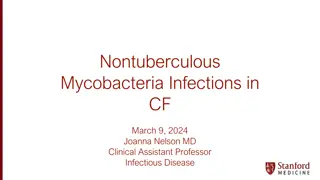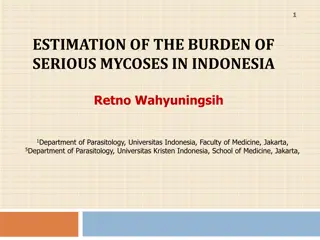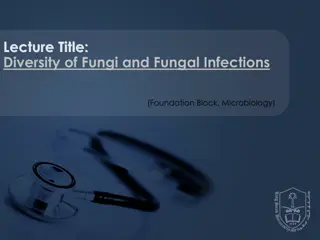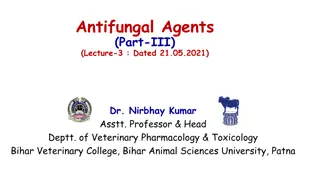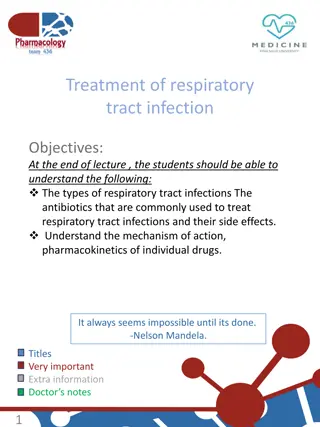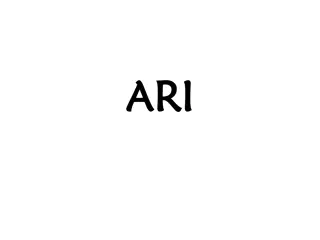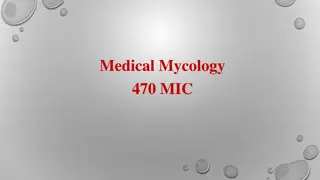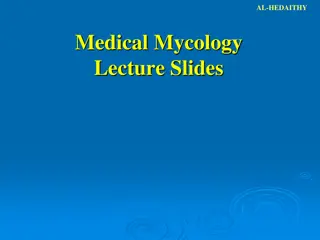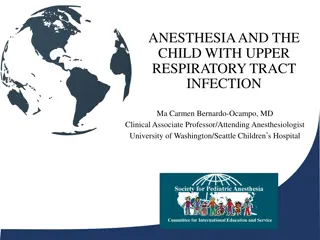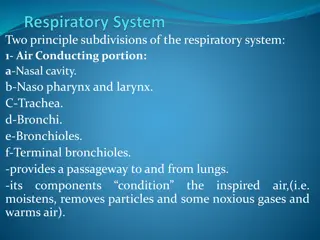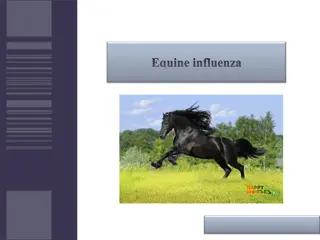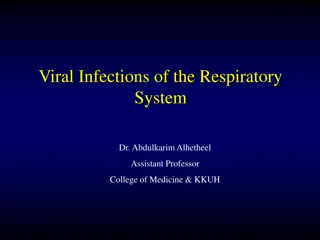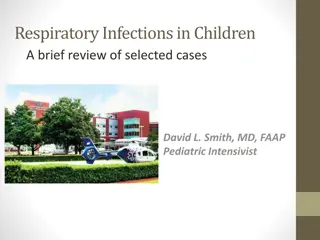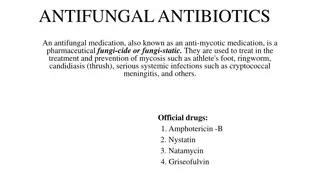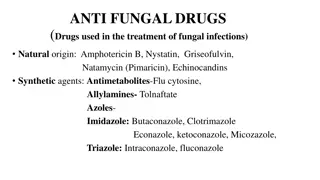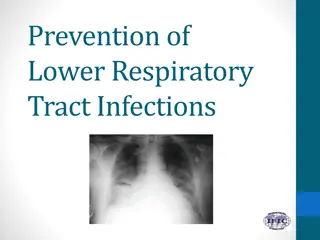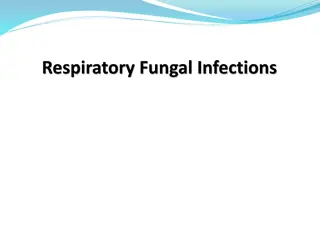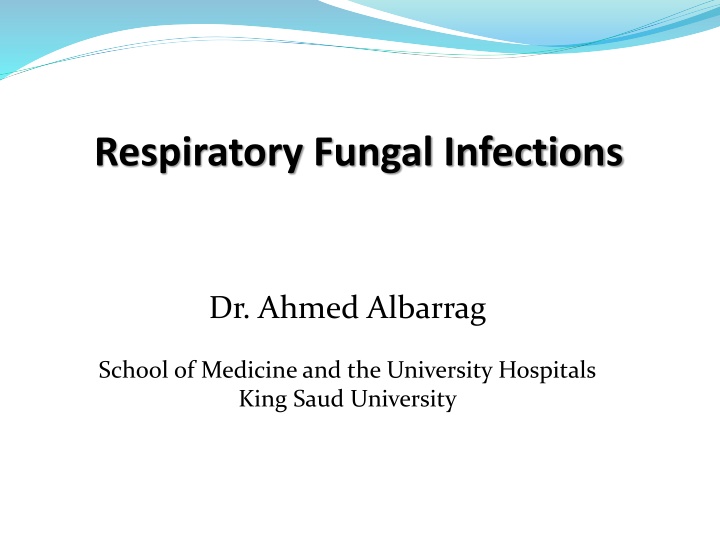
Respiratory Fungal Infections and Aspergillosis
Learn about respiratory fungal infections, including primary systemic mycoses and invasive aspergillosis. Explore the causes, symptoms, and treatment options for conditions like candidiasis, cryptococcosis, and chronic aspergillosis. Discover the routes of infection and risk factors associated with these fungal diseases.
Download Presentation

Please find below an Image/Link to download the presentation.
The content on the website is provided AS IS for your information and personal use only. It may not be sold, licensed, or shared on other websites without obtaining consent from the author. If you encounter any issues during the download, it is possible that the publisher has removed the file from their server.
You are allowed to download the files provided on this website for personal or commercial use, subject to the condition that they are used lawfully. All files are the property of their respective owners.
The content on the website is provided AS IS for your information and personal use only. It may not be sold, licensed, or shared on other websites without obtaining consent from the author.
E N D
Presentation Transcript
Respiratory Fungal Infections Dr. Ahmed Albarrag School of Medicine and the University Hospitals King Saud University
Respiratory System Rout of infection? Respiratory fungal infections are less common than viral and bacterial infections. Invasive diseases have significant difficulties in diagnosis and treatment.
YEAST Candidiasis (Candida and other yeast) Cryptococcosis (Cryptococcus neoformans, C. gattii) Mould fungi Aspergillosis (Aspergillus species) Zygomycosis (Zygomycetes, e.g. Rhizopus, Mucor) Other mould Dimorphic fungi Paracoccidioides brasiliensis Histoplasma capsulatum Coccidioides immitis Blastomyces dermatitidis
Primary Systemic Mycoses Infections of the respiratory system, (Inhalation ) Dissemination seen in immunocompromised hosts Common in North America and to a lesser extent in South America. Not common in other parts of the World. Etiologies are dimorphic fungi In nature found in soil of restricted habitats. Primary pathogens They are highly infectious They include: Histoplasmosis, Blastomycosis, Coccidioidomycosis, Paracoccidioidomycosis
Aspergillosis is a spectrum of diseases of humans and animals caused by members of the genus Aspergillus. These include (1) Mycotoxicosis (2) Allergy (3) Colonization (without invasion and extension ) in preformed cavities (4) Invasive disease of lungs (5) Systemic and disseminated disease. Aetiological Agents: Aspergillus species, common species are: A. fumigatus, A. flavus, A. niger, A. terreus and A. nidulans.
Invasive aspergillosis Airways/nasal exposure to airborne Aspergillus Chronic aspergillosis Aspergillomaof lung Maxillary (sinus) aspergilloma Persistence without disease colonisation of the airways or nose/sinuses - Allergic Allergic bronchopulmonary (ABPA) Allergic Aspergillus sinusitis
Bone marrow/ organ transplantation Cancer: Leukemia, lymphoma,.. etc AIDS Drugs: Cytotoxic drugs, steroids,.. etc Diabetes Others
Chronic Aspergillosis (Colonizing aspergillosis) (Aspergilloma OR Aspergillus fungus ball) Signs include: Cough, hemoptysis, variable fever Radiology will show mass in the lung , radiolucent crescent Invasive pulmonary Aspergillosis Signs: Cough , hemoptysis, fever, Leukocytosis Radiology will show lesions with halo sign
Invasive pulmonary aspergillosis Note the Halo sign
Aspergilloma Note the Air crescent
symptoms of Asthma Bronchial obstruction Fever, malaise Eosinophilia Wheezing +/- Also: Skin test reactivity to Aspergillus Serum antibodies to Aspergillus Serum IgE > 1000 ng/ml Pulmonary infiltrates
Common airborne Fungi Aspergillus fumigatus Aspergillus niger
Fungal sinusitis Clinical: Nasal polyps and other symptoms of sinusitis In immunocompromised, Could disseminate to eye craneum (Rhinocerebral) The most common cause in KSA is Aspergillus flavus In addition to Aspergillus, there are other fungi that can cause fungal sinusitis Aspergillus sinusitis has the same spectrum of Aspergillus disease in the lung Diagnosis Clinical and Radiology Histology Culture Precipitating antibodies useful in diagnosis Measurement of IgE level, RAST test Treatment : depends on the type and severity of the disease and the immunological status of the patient
Specimen: Respiratory specimens: Sputum, BAL, Lung biopsy, Other samples: Blood, etc. Lab. Investigations: Direct Microscopy: Giemsa Stain, Grecott methenamine silver stain (GMS) Will show fungal septate hyphae Culture on SDA Serology: Test for Antibody ELISA test for galactomannan Antigen PCR: Detection of Aspergillus DNA in clinical samples
Choice of antifungal for aspergillosis Voriconazole Alternative therapy Amphotericin B, Itraconazole, Caspofungin
Pulmonary zygomycosis Rhinocerebral zygomycosis Risk factors Transplant patients Malignancy AIDS Diabetic ketoacidosis Many others
Acute Consolidation , nodules, cavitation, pleural effusion, hemoptysis Infection may extend to chest wall, diaphragm, pericardium. Pulmonary infractions and hemorrhage Rapid evolving clinical course Early recognition and intervention are critical Etiology: Zygomycetes , Non-septate hyphae e.g. Rhizopus,
Specimen: Respiratory specimens: Sputum, BAL, Lung biopsy, Other samples Lab. Investigations: Direct Microscopy: Giemsa, Grecott methenamine silver stain (GMS) Will show broad non- septate fungal hyphae Culture on SDA (no cycloheximide) Serology: Not available Treatment: Amphotericin B Surgery
Pneumocystosis (PCP) Pneumocystispneumonia (PCP) Opportunistic fungal pneumonia It is interstitial pneumonia of the alveolar area. Affect compromised host Especially common in AIDS patients. Etiology: Pneumocystis jiroveci Previously thought to be a protozoan parasite, but later it has been proven to be a fungus Does not grow in laboratory media e.g. SDA Naturally found in rodents (rats), other animals (goats, horses), Humans may contract it during childhood
Pneumocystosis Laboratory Diagnosis: Patient specimen: Bronchoscopic specimens (B.A.L.), Sputum, Lung biopsy tissue. Histological sections or smears stained by GMS stain. Immunuofluorescence (better sensitivity) If positive will see cysts of hat-shape, cup shape, crescent Treatment: Trimethoprim sulfamethoxazole Dapsone

